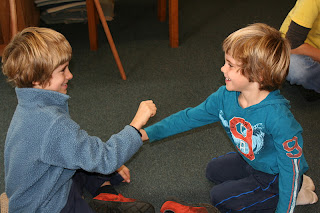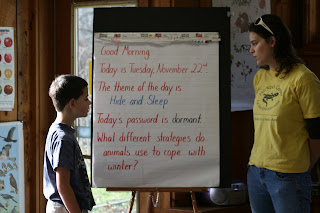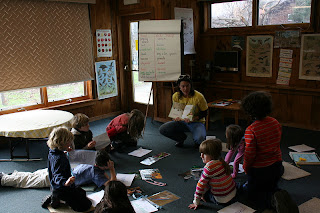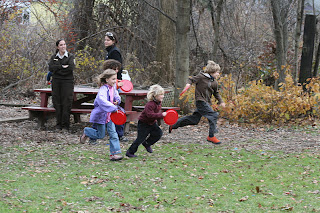Hello!
Whew, another whirlwind of a day here at homeschool. Our second to last
class! Our morning game was fishy fishy cross my ocean. Always a favorite!
Today’s greeting was a choice between a pound (touching fists), a high five, or
a silly animal, like a snail or turkey. (See photo!)
Then we reviewed what our passwords have been all session.
Impressively, kids remembered difficult words like curcubitaceae, and
long-ago words like harvest (way back in September). Parents, prepare to
learn all about the passwords next time at our last class!
Kids then shared home projects. They had been doing lots of
thinking in the last week about how they stay warm in the winter (everything
from “migrating” to California to generating heat by eating pumpkin seeds!).
We read the morning message and introduced the theme of the
day: Cozy and Warm. The password is insulation. We discussed what insulation is
and demonstrated by doing an experiment. Kids picked what material they wanted
to insulate with and each pair was given a jar to insulate. Then we took the
temperature of boiled water – about 188° - and poured it into the
jars. We insulated our jars the best we could, and left one without insulation
to be our control. Then, since the weather was so warm outside, we decided to
put the jars in the freezer to test how well we insulated the jars. We recorded
all our information on our insulation sheets.
Then everyone got a turn to try on the "blubber gloves" and put their hands in ice water. On one hand was just a plastic baggie. On the other was a "glove" of plastic baggies with Crisco (pretend animal fat) inside. Which one was better insulated?
After a quick snack, we went outside for our adventure. We
marched to Larch Hill, where we were given a challenge: build the most
insulated shelter you can using materials from the forest. Everyone built
something really different and did a great job. One was expertly camouflaged.
One had fun details like a slide for fairies. And one was big enough to fit
several homeschoolers!

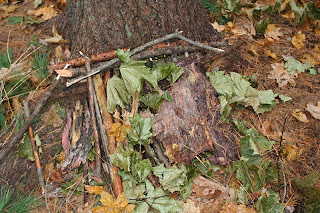
When we were done with our challenge we headed back to the
Hitchcock Center by way of the farm. We were looking for a red-tailed hawk that
we had startled from her roost, but we couldn’t find her again. (I think it was
a female because she was so big!) We played in the cattails and made sure the
praying mantis egg case was still there, and then we had to be on our way.
We ate lunch and then checked our jars in the
freezer. The results were interesting! Some you could tell the difference in
temperature just by touching. Some had leaked, with water frozen to the
material. Everyone had a chance to record the temperature of their jars, and to
compare their results with their prediction. See our results in the photo.
Next, some of us worked on journals while others did our craft for the day: an insulating snake for drafty doorways. We filled tubes of material with sand, beans and rice and then hot glued eyes and tongues on. They came out awesome! A huge thank you to Carole and Betsy for helping out.




